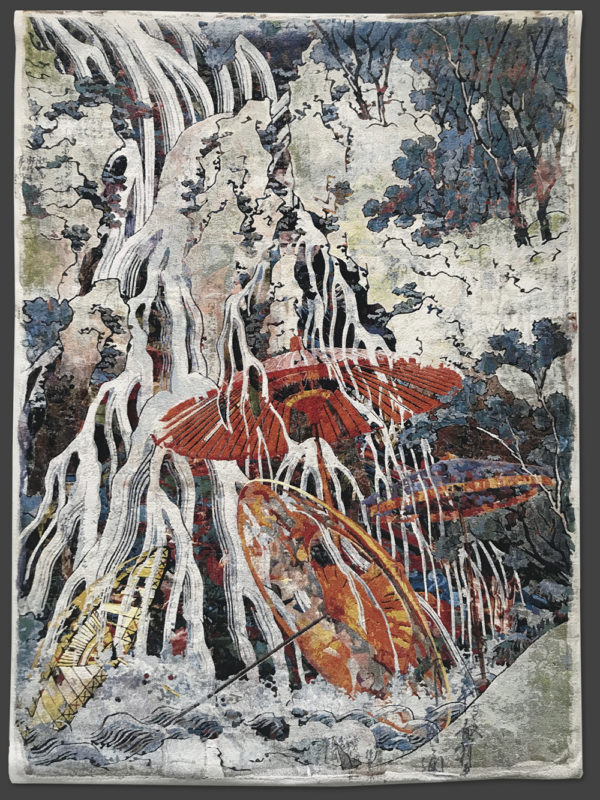
Jacquard tapestry
96 x 68.5 in
Edition of 6
Since the earliest myths were conceived, the sun has symbolized the power of nature in humanity’s conception of its relationship to the environment and the sacred. From ancient Indian sages who associated the sun with enlightenment (eventually inspiring the halo in Christian art) to the contemporary issue of global warming, the sun is a literal and symbolic representation of both the nurturing and the destructive powers of the environment. As such, in artworks from all over the world and across recorded time, a potent symbol of the relationship between humanity and the environment can be found in the form of the umbrella. Several of Donald and Era Farnsworths’ recent works, exhibited under the title I Forget I’m Human, draw upon the umbrella to represent humanity’s coexistence with nature as we strive — regardless of epoch or nationality — for a balanced and spiritually meaningful existence.
The umbrella is assigned a powerful spiritual significance in various traditions. Widely used in Hindu religious processions, parasols appear throughout the stories in the ancient epic Mahabharata. The parasol is also a nearly ubiquitous presence in Buddhist iconography, where the umbrella or parasol represents protection from illness, obstacles, harmful energies and suffering experienced in the three lower realms of existence. In the Buddha’s dying instructions, his followers were forbidden to worship representations of him; as a result, he is often depicted as a pair of footprints or an empty space beneath an umbrella. To the Farnsworths this “empty space” under the parasol — perhaps Dharmakaya, the invisible mind-body of Buddha (or any sentient being) — represents a protection of civilized thoughts and concepts, a passing and sharing of precious knowledge. In Parasol Fall the waterfall passing over and through the parasols gives a sense of a blurring of dimensions, a floating, unfixed location in time and space. The domed top of the parasol is said to represent wisdom; the tassels represent compassion; and the shaft is a representation of the human spine. Around the vertebrae are three energy channels by which kundalini energy travels from the base of the spine into the brain, illuminating the initiate.
The umbrella has also been a frequent historical accessory to romance and seduction, from Catherine Deneuvre in 1964’s “The Umbrellas of Cherbourg” to 2,000-year-old Roman texts like Ovid’s Ars Amatoria (The Art of Love), which advised would-be suitors to humble themselves by protecting their love interests from the sun: “You yourself must hold her parasol above her / And with it clear her way ahead through the crowds.” In the story of Hercules, when the hero is enslaved by Queen Omphale, he is said to carry her golden parasol; a famous 1948 photograph of Picasso carrying a parasol to shelter his lover and muse Francoise Gilot re-enacts this mythic gesture of romance. – Nick Stone
show prices
Prices and availability are subject to change without notice.The copyright of all art images belongs to the individual artists and Magnolia Editions, Inc.
©2003-2026 Magnolia Editions, Inc. All rights reserved. contact us
